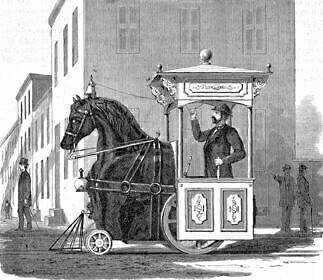Updated: 17 Dec 2007




The Steam Horse Locomotive. |
Updated: 17 Dec 2007
 
|
 | Left: The Steam Horse Locomotive.
|
The inventor speaks:
"The design is to make a machine resembling a horse in form, so as not to frighten the horses on the streets. To this end the form shown is chosen. The motive power is steam, generated in a tubular boiler of from four to five horse power, located inside of the horse and forward of the cab. This drives a rotary engine of my own patenting, which is geared to the driving shaft of the machine. I also propose the use of gas as fuel, so as to do away with smoke. The steam is condensed in cold water carried in a tank of sufficient capacity on top of the cab. Gas is compressed in suitable tanks to a pressure of from 80 to 100 lbs. per square inch, and is used as fuel. The boiler is so constructed as to receive a supply of hot air to feed the flame the gases from which, after passing around the boiler. are conducted around the engine to prevent loss by condensation. The water is forced into the boiler from the condensed steam chamber. The engine is provided with a brake capable of stopping the apparatus within a space of twenty feet, while under a speed of eight miles per hour."
This sounds less than impressive as a technical proposal. Compressed gas has, I think, never been used to fuel locomotives, probably because the energy storage density is inadequate, especially at a pressure as low as 100 psi. As for the condensing capability, which would have been considered essential to avoid frightening the real horses on the street with clouds of exhaust steam, it seems highly unlikely that "a tank of sufficient capacity" for continuous condensing could have been fitted on top of the cab, given the experiences of condensing locomotives on the underground London Metropolitan Railway.
And it has to be said that the choice of a rotary steam engine does not inspire confidence in the project, as by this period they were widely known to be too inefficient to be practical.
It should be possible to track down that patent for a rotary steam engine...
   
|